Cancer of any type can be devastating, and testicular cancer is no different. Understanding important facts, such as risk factors for developing testicular cancer, can be helpful. When you’re equipped with knowledge, you’re prepared to protect yourself and perhaps your loved ones.
Below, learn about some of the top testicular cancer statistics for one or both testicles. These will provide insight into who gets testicular cancer, as well as current testicular cancer rates.
Key Testicular Cancer Facts
- It is estimated that 9,190[1] people in the U.S. will receive a testicular cancer diagnosis in 2023.
- Around 470[1] people in the U.S. will die from testicular cancer in 2023.
- The five-year survival rate for testicular cancer was 95.2%[1] in the U.S. between 2013 and 2019.
- Among all new cancer cases, 0.5%[1] are testicular cancer.
- In 2020, there were 74,500[2] new cases of testicular cancer across the globe.
The median age for testicular cancer diagnosis is 32 years old.[1]
Testicular Cancer Statistics In The United States
How Has The Rate Of Testicular Cancer Changed Over Time?
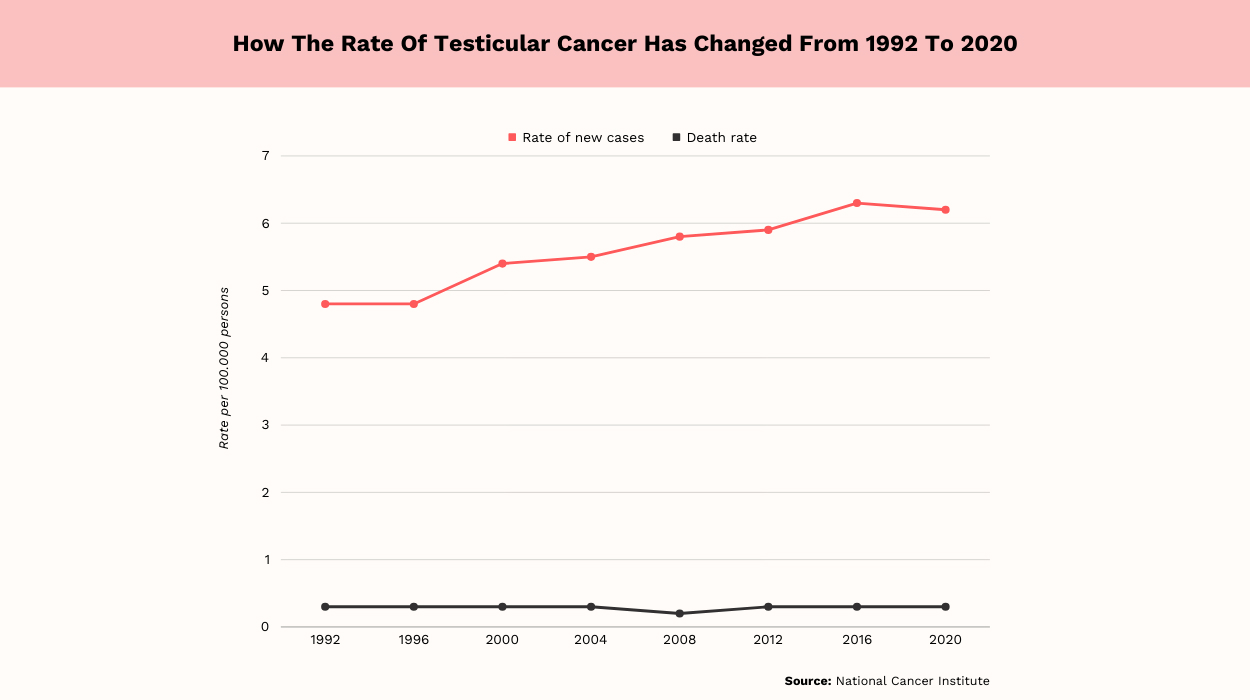
- In 1992, the rate of new testicular cancer cases was 4.8[1] per 100,000 people in the population.
- As of 2020, the rate had increased to 6.2[1] per 100,000 people.
- In 2016 and 2017, respectively, the rate was 6.3[1] per 100,000 people.
- In 2014, the testicular cancer rate was 6.4[1] per 100,000.
- The death rate from testicular cancer was 0.3[1] per 100,000 people in both 1992 and 2020.
Rates of testicular cancer have increased[1] slightly between 1992 and 2020. There was a peak in 2014 of 6.4[1] new testicular cancer cases per 100,000 people. However, the 2020 rate is still higher than the rate in 1992.
Testicular cancer deaths have remained stable[1] over time. The 1992 rate was the same as the 2020 death rate.
The death rate has been as low as 0.2[1] per 100,000 people several times between 1992 and 2020. Regardless, there has not been much variation since 1992.
According to Dr. Danielle Leonardo, a Medical Oncologist practicing in the Philippines, “There are no clear explanations yet as to why the incidence of testicular cancer is increasing.” She further states, “Some hypotheses include that the risk of testicular cancer is associated with increasing maternal weight.”
Dr. Leonardo also offers, “Obesity and type 2 diabetes are pro-inflammatory conditions that
may increase the risk of developing testicular cancer.”
Who Gets Testicular Cancer?
Testicular Cancer Statistics By Age
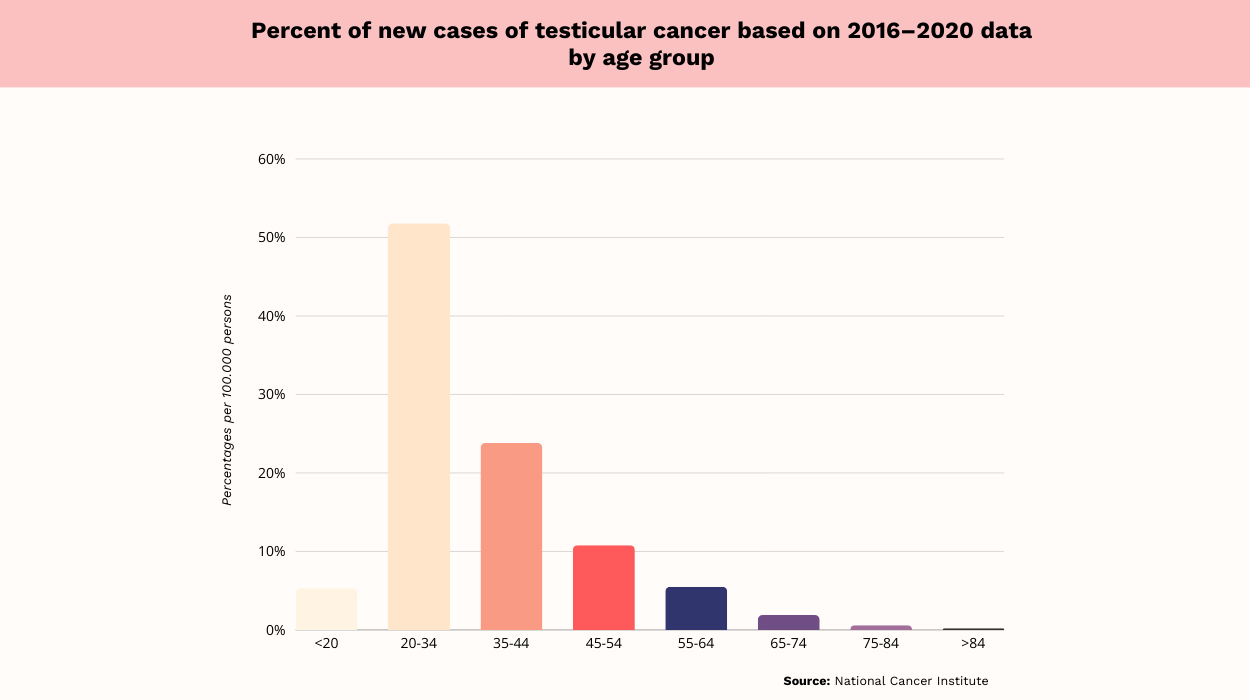
The testicular cancer incidence is as follows based on age:
- Under 20: 5.3%.[1]
- Ages 20-34: 51.8%.[1]
- Ages 35-44: 23.8%.[1]
- Ages 45-54: 10.8%.[1]
- Ages 55-64: 5.5%.[1]
- Ages 65-74: 1.9%.[1]
- Ages 75-84: 0.6%.[1]
- Older than 84: 0.2%.[1]
The highest[1] incidence of testicular cancer is in those aged 20 to 34, followed by those aged 35 to 44. After age 35 to 44, there is a decline[1] in testicular cancer incidence with increasing age.
It is clear that testicular cancer is most common in young men. Dr. Sandeep Nayak, a surgical oncologist, states that there are several possible explanations for this fact. He says, “Young men are more likely to have undescended testicles, which is a significant risk factor.” Dr. Nayak adds, “Certain genetic mutations associated with testicular cancer are more prevalent in younger populations.”
Testicular Cancer Statistics By Race/Ethnicity
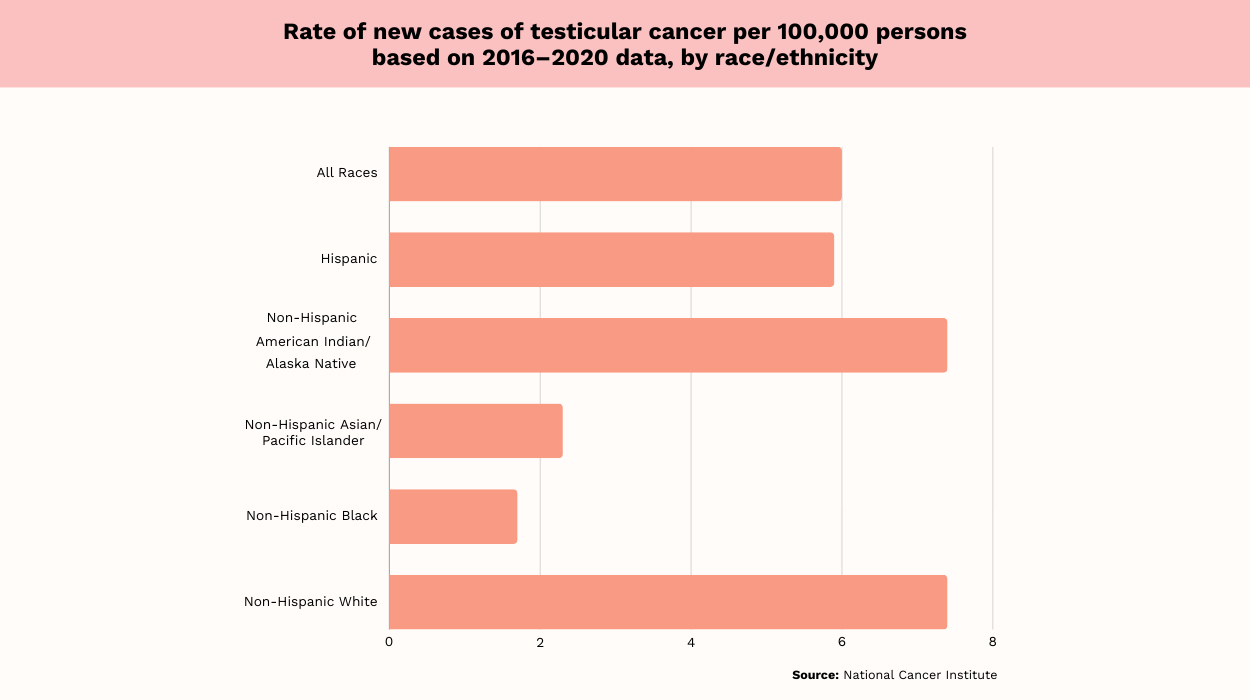
- Among all races, the rate of new cases of testicular cancer is 6.0[1] per 100,000 people.
- In Hispanics, the testicular cancer incidence is 5.9[1] per 100,000.
- In non-Hispanic American Indian/Alaskan Natives, the incidence is 7.4[1] per 100,000.
- In non-Hispanic Asian/Pacific Islanders, incidence is 2.3[1] per 100,000.
- In non-Hispanic Blacks, the incidence is 1.7[1] per 100,000.
- In non-Hispanic Whites, the incidence is 7.4[1] per 100,000.
The incidence of testicular cancer is highest[1] in non-Hispanic Whites and non-Hispanic American Indian/Alaskan Natives. The lowest[1] incidence is in non-Hispanic Blacks, followed by non-Hispanic Asians/Pacific Islanders.
Testicular Cancer Death Rate
Percent Of Deaths By Age Group
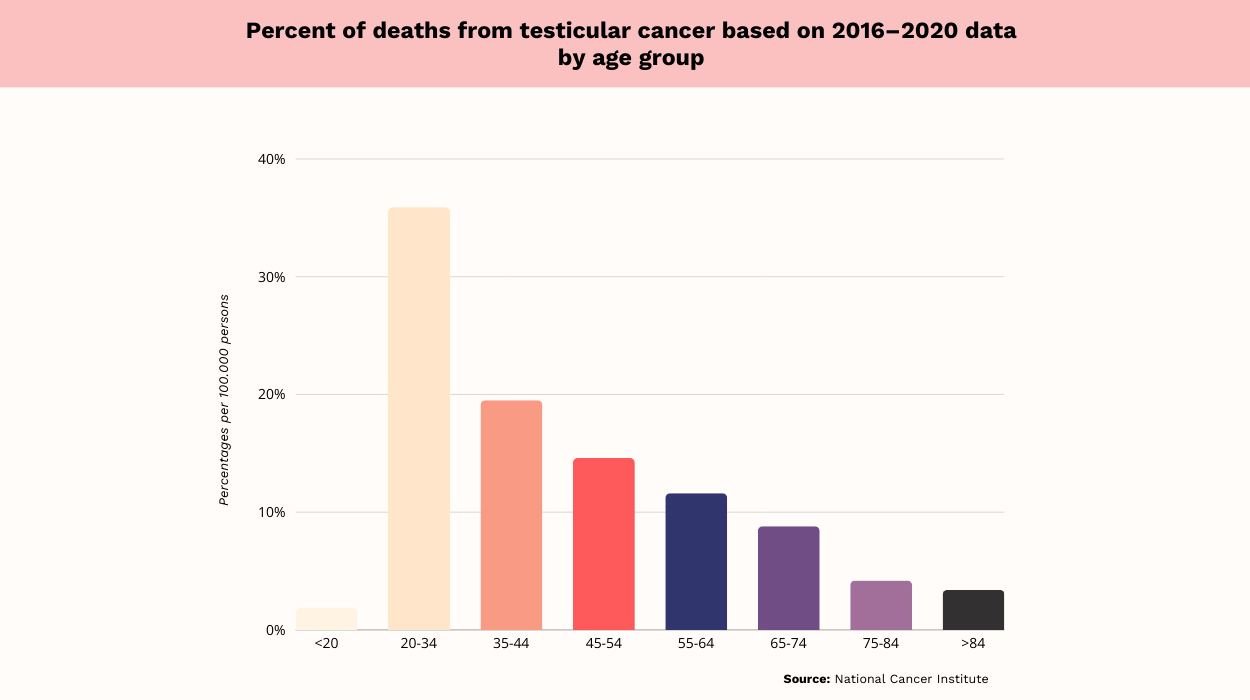
Testicular cancer death rates vary based on age. The percentage of deaths attributed to each age group is as follows:
- Under 20: 1.9%.[1]
- Ages 20-34: 35.9%.[1]
- Ages 35-44: 19.5%.[1]
- Ages 45-54: 14.6%.[1]
- Ages 55-64: 11.6%.[1]
- Ages 65-74: 8.8%.[1]
- Ages 75-84: 4.2%.[1]
- Older than 84: 3.4%.[1]
The largest percentage[1] of testicular cancer mortality occurs in ages 20 to 34, followed by ages 35 to 44. The lowest[1] mortality rate is in those under 20, followed by those older than 84.
Death Rate By Race/Ethnicity
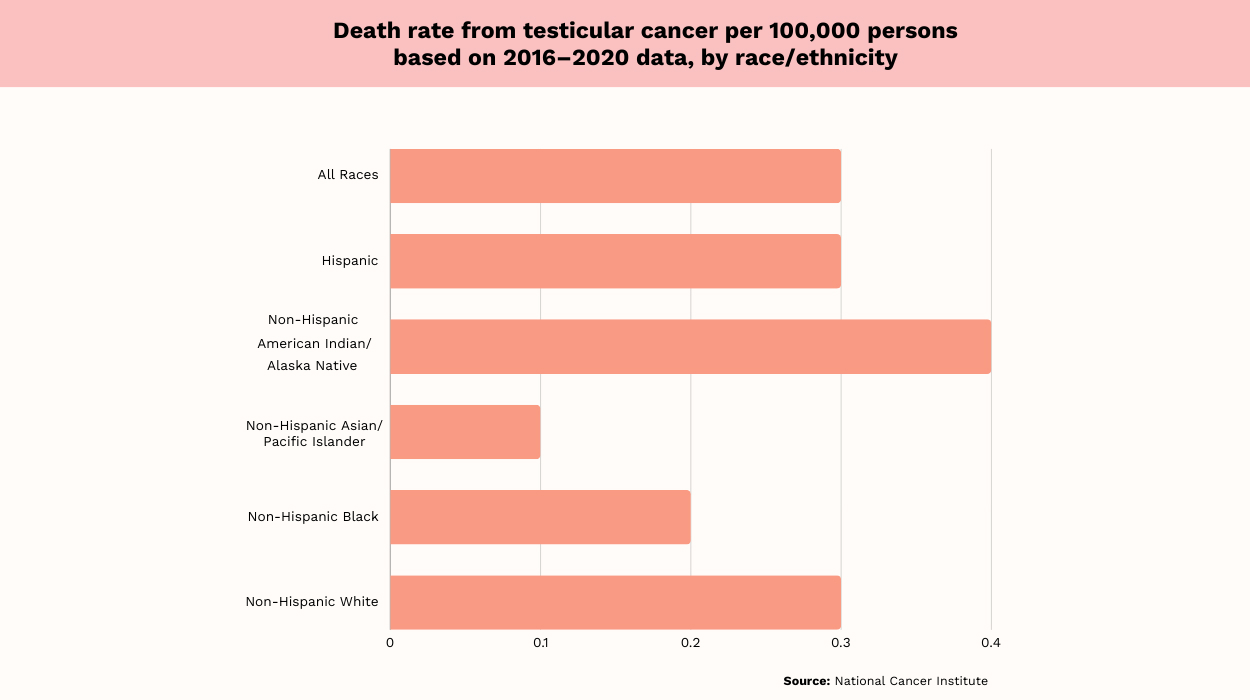
The testicular cancer mortality rate per 100,000 people, based on race/ethnicity, is as follows:
- All races: 0.3.[1]
- Hispanic: 0.3.[1]
- Non-Hispanic American Indian/Alaskan Native: 0.4.[1]
- Non-Hispanic Asian/Pacific Islander: 0.1.[1]
- Non-Hispanic Black: 0.2.[1]
- Non-Hispanic White: 0.3.[1]
The testicular cancer mortality rate per 100,000 people is under[1] one for all races. It is highest among[1] non-Hispanic American Indian/Alaskan Natives. The lowest[1] death rate is in non-Hispanic Asian/Pacific Islanders.
Testicular Cancer Survival Rate
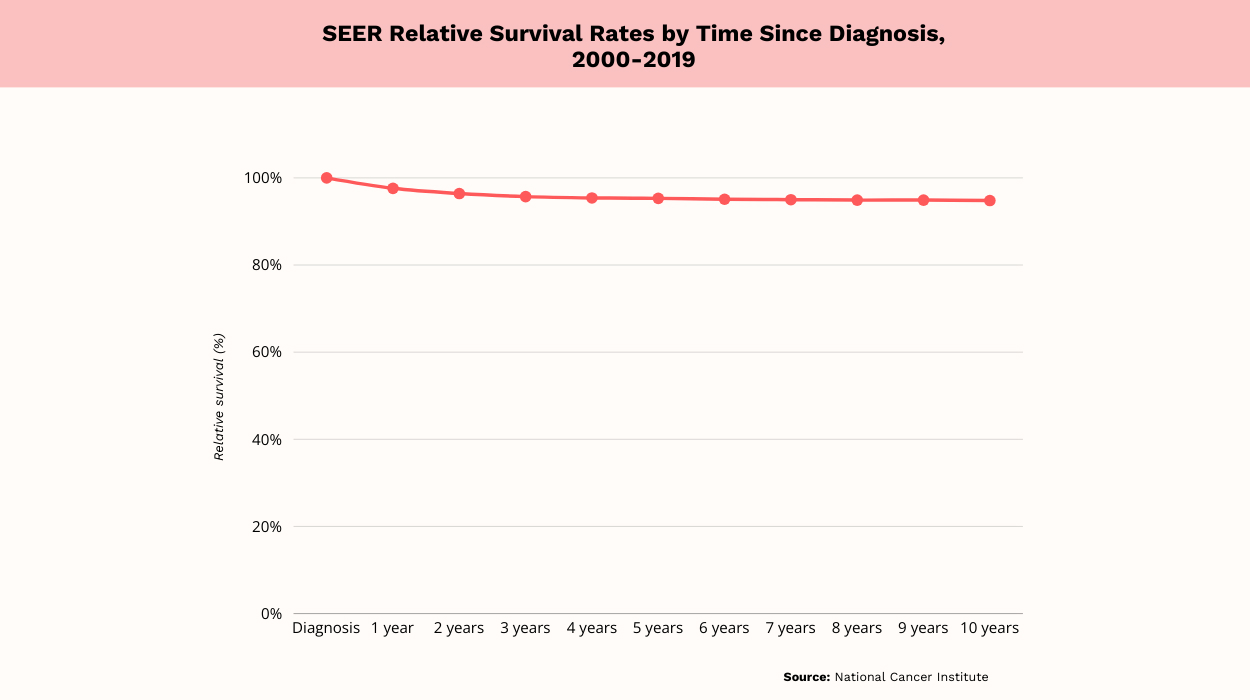
In the United States, overall, the 5-year survival among people diagnosed with testicular cancer was 95.2%[1] from 2013 to 2019, according to the Seer Cancer stat facts.
From 2000 to 2019, the relative 5-year survival rate based on time since diagnosis was as follows:
- One year: 97.6%.[3]
- Two years: 96.4%.[3]
- Three years: 95.7%.[3]
- Four years: 95.4%.[3]
- Five years: 95.3%.[3]
- Six years: 95.1%.[3]
- Seven years: 95.0%.[3]
- Eight years: 94.9%.[3]
- Nine years: 94.9%.[3]
- Ten years: 94.8%.[3]
There is a slight decline in survival rates with increasing time since testicular cancer diagnosis. However, the overall survival rates are quite high, even ten years after diagnosis.
Testicular Cancer Survival Rate By Age
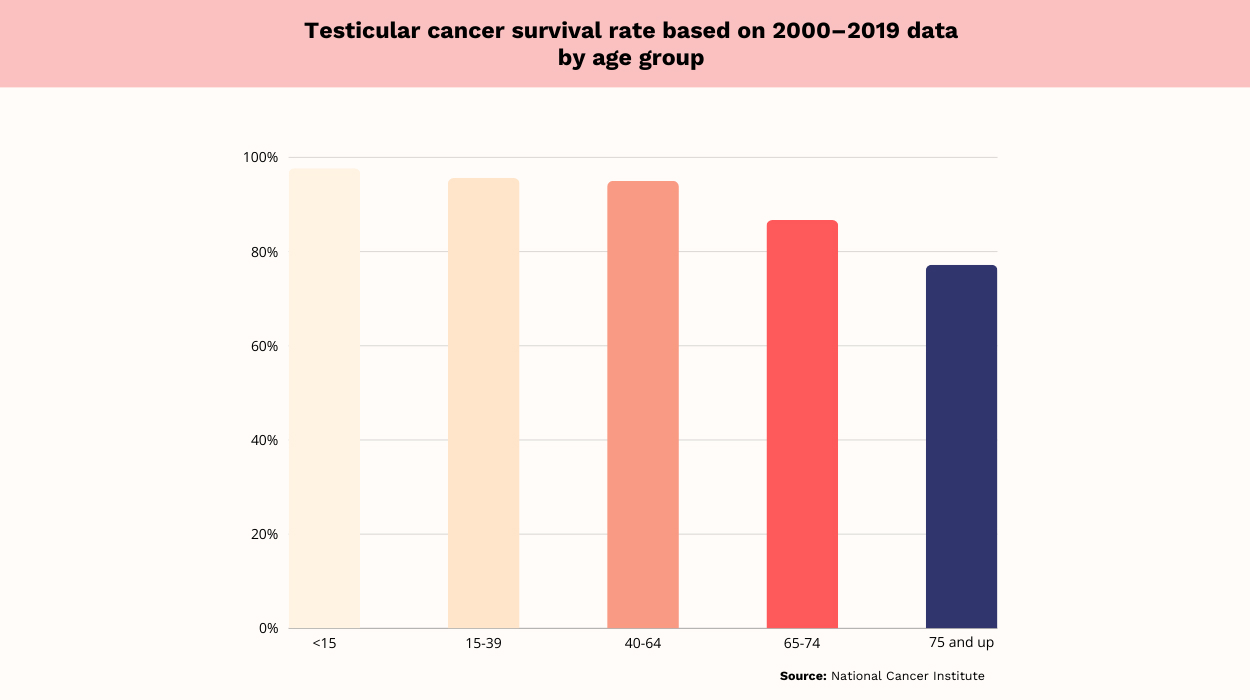
The 5-year survival rate among people who develop testicular cancer, based on age, is as follows:
- Under 15: 97.7%.[3]
- Ages 15-39: 95.6%.[3]
- Ages 40-64: 95.0%.[3]
- Ages 65-74: 86.7%.[3]
- Ages 75 and up: 77.2%.[3]
Survival statistics show that the testicular cancer survival rate varies based on age. There is a slight decline in survival rate from under the age of 15 through ages 40-64. After this point, survival rates decline for ages 65 to 74 and ages 75 and older.
Testicular Cancer Facts To Know
In addition to the incidence and mortality data above, there are other testicular cancer facts to know. Consider the data below.
Testicular Cancer Has Differing Impacts In Various Parts Of The Globe
The highest incidence rates of testicular cancer are seen in Western, Northern, and Southern Europe, as well as in Oceania. In these locations, the incidence is at least 7 per 100,000[2] people. The second-highest incidence is in North America, with a rate of 5.6[2] per 100,000.
The lowest incidence rates of testicular cancer are in Asia and Africa, where the incidence is less than 2 per 100,000[2] people.
Globally, the highest mortality rates from testicular cancer are in Central and South America. In these locations, the death rates per 100,000 are 0.84[2] and 0.54,[2] respectively.
The lowest mortality rates are in Northern Europe, at 0.16[2] per 100,000, and Northern Africa, at 0.14[2] per 100,000.
Testicular Cancer Isn’t One Of The Most Common Cancers Globally.
If you ask, “How common is testicular cancer?” you might be interested in global incidence. As of 2020, there were 74,500[2] new cases of testicular cancer globally. This makes this form of cancer the 20th[2] most common across the globe.
Testicular Cancer Is Uncommon Compared To Other Cancers In The U.S.
Among all cancer types, testicular cancer isn’t very common. It’s the 25th[1] most common cancer in the United States, making it a rare disease.
In 2023, the estimated number of new testicular cancer cases is 9,190.[1] Compare this to the 297,790[1] new female breast cancer cases expected in 2023.
Is Testicular Cancer Deadly?
It is common for people to ask, “Is testicular cancer fatal?” The truth is that it can be, but testicular cancer isn’t known as one of the deadliest cancers.
There will be an estimated 470[1] testicular cancer deaths in 2023. On the other hand, 127,070[1] people are expected to die from lung and bronchus cancers, the deadliest type.
It is also helpful to consider that the overall 5-year survival rate after diagnosis is 95.2%.[1] Testicular cancer survival rates decline with advancing age. However, the 5-year survival rate remains 77.2%[3] in those aged 75 and above.
Survival Rate By Stage
While testicular cancer is generally not deadly, the survival rate can vary by the stage at diagnosis. The stage 1 testicular cancer survival rate is 94.1%[4] after five years, according to a recent study.
The stage 2 testicular cancer survival rate is 87.5%[4] after five years. Finally, for stage 3 testicular cancers, the five-year survival rate is 66.7%.[4] Based on these findings, the survival rate decreases with more advanced stages.
Testicular Cancer Risk Factors
Some people are more likely than others to develop testicular cancer. According to the American Cancer Society, several factors increase the risk of testicular cancer. These include:[4]
- Being born with an undescended testicle.
- Having a family history of testicular cancer.
- Having a family history of a genetic condition called Klinefelter’s syndrome.
- Infection with HIV, especially if it progresses to AIDS.
- Having a condition called carcinoma in situ, meaning the cancerous cells are localized.
- Having a history of cancer in one testicle increases the future risk of cancer in the other.
- Being between the ages of 20 and 34.
- Being white, the risk is three to four times higher in White men compared to Black and Asian American men.
Global research[5] shows that other factors may increase the risk of testicular cancer. These include alcohol consumption, obesity, lack of physical activity, and high blood cholesterol.
Testicular Cancer Prevention
The American Cancer Society reports that many men who develop testicular cancer don’t have any risk factors. So, prevention may not be possible.
However, factors like alcohol consumption, obesity, lack of exercise, and high blood cholesterol can increase the risk.[5] This suggests that men could reduce their testicular cancer risk by making healthy lifestyle changes. Getting regular exercise, following a heart-healthy diet, and maintaining a healthy weight could be important for risk reduction.
Testicular Cancer Symptoms
If you or a loved one is worried about testicular cancer, it’s important to be aware of the symptoms. The common symptoms[6] associated with this disease include:
- A lump in the testicle.
- Swelling or enlargement of the testicle.
- Heavy or achy feeling in the lower belly or scrotum.
- Rarely soreness or growth in the breasts.[7]
In more advanced metastatic disease stages, testicular cancer may cause the following symptoms:[8]
- Lower back pain if cancer has spread to lymph nodes.
- Shortness of breath, chest pain, and coughing up blood if cancer is also in the lungs.
- Belly pain due to enlarged lymph nodes or spread of cancer to the liver.
- Swelling or lump in the neck.
Testicular Cancer Diagnosis And Treatment
If a man presents with symptoms related to testicular cancer, a doctor will perform testing to make a diagnosis. Imaging tests[9] like scrotal ultrasonography can detect a mass in the testicles.
Once a diagnosis is made, an oncologist will develop a treatment plan. Stage 1 germ cell cancers are typically treated with orchiectomy.[9] This is a procedure in which the testicle is surgically removed.
After initial treatment, a patient will continue to be monitored for recurrence. Some testicle cancers may be treated[10] with radiation therapy or chemotherapy. A particular type of treatment called cisplatin-based[11] chemotherapy has significantly improved the outlook for patients with testicular cancer.
According to Dr. Leonardo, “Early stages of testicular cancer can be treated with orchiectomy or surgical removal of the involved testes.” She further adds, “Depending on the findings, the patient may need additional radiation therapy or a short course of chemotherapy after surgery.”
She explains that the treatment is longer for later stages of testicular cancer, which “will require longer courses of chemotherapy involving at least three drugs.” Dr. Leonardo states that for advanced stages, chemotherapy may be followed by surgery or radiation therapy. “Some cases of testicular cancer are also offered stem cell transplantation for difficult-to-treat cancers,” she says.
The Bottom Line
Testicular cancer rates have increased slightly[1] since 1992. However, this remains an uncommon form of cancer, ranking as the 25th most common[1] cancer in the U.S.
One of the most important questions people probably have about this cancer is, “Can testicular cancer kill you?” The answer is that the vast majority of people survive this kind of cancer. It is highly treatable and curable.
Nonetheless, it’s important to see a doctor if you have symptoms. Early treatment increases the chances of a cure.
Frequently Asked Questions
Testicular cancer is highly curable. Research shows that over 95%[11] of patients are cured.
Studies[11] have found that most men experience a high quality of life after surviving testicular cancer. However, lasting erectile dysfunction[12] and problems with sexual functioning are common in survivors.
Most testicular cancers[13] are called germinal tumors, as they begin in a sperm-forming germ cell. There are several types of germinal tumors, which vary in aggressiveness. Whether testicular cancer spreads depends on the specific type.
Prevention measures for testicular cancer are limited. Many men who develop this cancer have no known risk factors. You might be able to reduce your risk with exercise and maintaining a healthy weight.
 Evidence Based
Evidence Based
